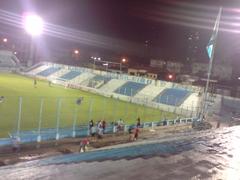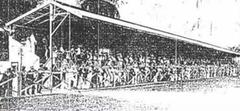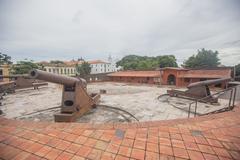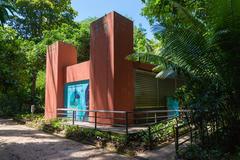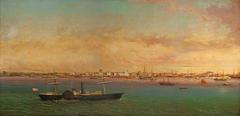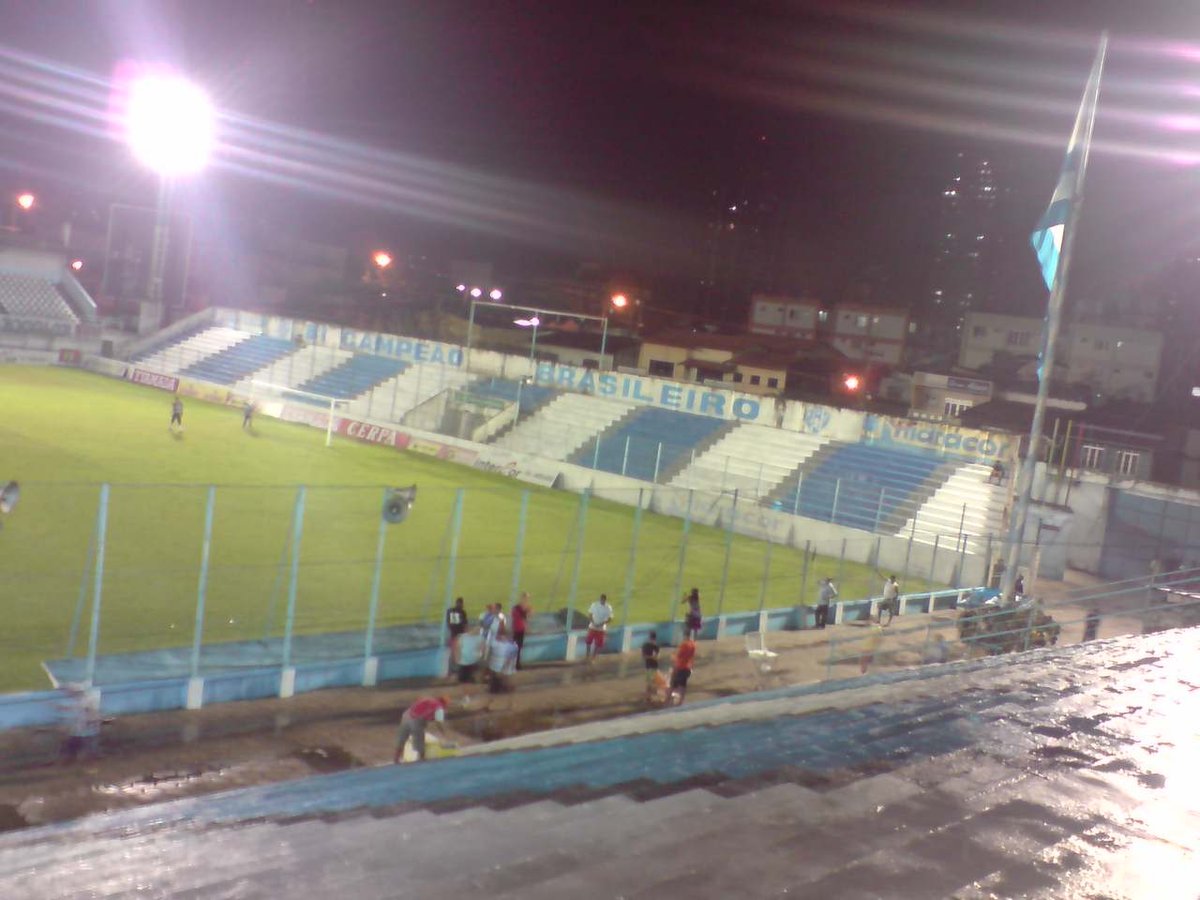
Estádio da Curuzú Visiting Hours, Tickets, and Travel Guide — Belém Historical Sites
Date: 15/06/2025
Introduction: The Historic Heart of Belém Football
Estádio da Curuzú, officially named Estádio Leônidas Sodré de Castro, stands as a proud symbol of Belém, Pará, Brazil. As the oldest football stadium still in use in the state—affectionately known as “Vovô da Cidade” (Grandfather of the City)—it is a living testament to over a century of Amazonian football tradition and community spirit. Since its inauguration on June 14, 1914, the stadium has been the spiritual home of Paysandu Sport Club, a team whose legacy is tightly interwoven with the social and cultural fabric of northern Brazil.
More than a venue for thrilling matches, including the legendary “Re-Pa” derby versus Clube do Remo, Estádio da Curuzú is a hub of local traditions, hosting community events, concerts, and festivals. Its central location in the Curuzú district, modern amenities, and guided tours make it an essential stop for football enthusiasts and cultural travelers alike. For current visiting hours, ticketing, and accessibility information, always consult the Paysandu Official Website or trusted local sources before your visit (Wikipedia; CNN Brasil; Paysandu Official Website).
Table of Contents
- Introduction
- Origins and Development
- Architectural Evolution and Capacity
- Cultural Significance
- Visiting Hours, Tickets, and Tours
- Getting There and Travel Tips
- Stadium Facilities & Matchday Experience
- Safety, Accessibility, and Visitor Tips
- Nearby Attractions
- FAQ
- Conclusion
- References
1. Origins and Development
Estádio da Curuzú traces its origins to the early 20th century, opening its doors in 1914 thanks to the efforts of Paysandu Sport Club. The stadium’s name is derived from its location on Rua Curuzú, reflecting indigenous influences, while its full title honors Leônidas Sodré de Castro, a pivotal figure in the club’s history. Its foundation marked a significant milestone in the Amazon region’s embrace of football (Wikipedia).
2. Architectural Evolution and Capacity
Throughout its history, Estádio da Curuzú has evolved to meet the needs of an ever-growing fanbase. Major renovations in the 1930s, 1970s, and 2000s introduced new seating, improved safety, and increased capacity, now accommodating approximately 16,200 spectators. Notable upgrades include a large electronic scoreboard and modernized locker rooms, all while preserving the stadium’s historic charm (Wikipedia; ge.globo.com).
3. Cultural Significance
Beyond football, Curuzú is a cultural beacon in Belém. An epicenter of local pride, it is renowned for the electric atmosphere generated by the “bicolores” (Paysandu supporters), especially during the fiercely contested “Re-Pa” derbies. The stadium’s role extends to hosting concerts, festivals, and community gatherings, solidifying its status as a unifying landmark in the city (CNN Brasil).
4. Visiting Hours, Tickets, and Tours
Visiting Hours
The stadium is open to the public primarily on matchdays and for guided tours. Guided tours are usually available Tuesday to Saturday, from 9:00 AM to 5:00 PM, though times may vary during football season or special events. Always confirm the current schedule via the Paysandu Official Website.
Tickets
Tickets for matches can be purchased online, at the stadium’s box office, or authorized vendors. Prices typically range from BRL 20 to BRL 60 (USD 4–12), with higher rates for major matches such as the “Re-Pa” derby. Guided tour tickets are affordable and offer exclusive access to key stadium areas.
Accessibility
Estádio da Curuzú has made significant strides in accessibility: ramps, designated seating areas, accessible restrooms, and trained staff are available to assist visitors with disabilities. Contact the club in advance to ensure a seamless visit (Paysandu Official Website).
Guided Tours & Events
Guided tours provide an immersive experience, including access to the pitch, locker rooms, trophy displays, and museum exhibits. The stadium also offers special events such as fan meetups, centenary celebrations, and cultural festivals (Museu Virtual do Futebol).
5. Getting There and Travel Tips
Located at Av. Almirante Barroso, 654, in the Marco neighborhood, the stadium is easily reached by public transportation, taxi, or ride-sharing services. Bus routes along Av. Almirante Barroso connect major neighborhoods, and taxis or ride-shares are recommended, especially on busy matchdays. Parking is limited; plan to arrive early or use public transit (Anita Beyond Thesea).
Travel Tip: The dry season (July–December) offers the most pleasant weather for stadium visits. Always bring water and sun protection.
6. Stadium Facilities & Matchday Experience
Estádio da Curuzú accommodates 16,200 fans with a variety of seating options, including general stands, 1,800 reserved seats, and 40 VIP boxes. The Bistrô Bicolor restaurant beneath the main stand offers local cuisine and international dishes, while snack bars and street vendors provide classic stadium fare such as pastel, coxinha, and açaí bowls (Wikipedia PT). Restrooms and merchandise kiosks are conveniently located throughout the venue.
Atmosphere: Matchdays are vibrant, with fans donning blue and white, singing club anthems, and creating a festive environment. The “Re-Pa” derby, in particular, is a cultural spectacle not to be missed (ge.globo.com).
7. Safety, Accessibility, and Visitor Tips
While the stadium and its events are generally safe, exercise caution as you would in any large city:
- Avoid displaying valuables.
- Use official transportation and avoid isolated areas at night.
- Keep personal items secure, especially in crowds.
- Women traveling alone report positive experiences, but standard safety precautions apply (Hikersbay; carolinerosetravel.com).
8. Nearby Attractions
Estádio da Curuzú’s central location makes it ideal for combining a stadium visit with other highlights:
- Ver-o-Peso Market: Renowned for its Amazonian produce and vibrant local life.
- Theatro da Paz: A stunning 19th-century opera house.
- Estação das Docas: Riverside complex with restaurants and shops.
- Praça da República: Lively urban square with gardens and cultural events.
Accommodation options range from budget hostels to international hotels in nearby Nazaré and Campina neighborhoods (Postcard from Taylor).
9. Frequently Asked Questions (FAQ)
What are the visiting hours for Estádio da Curuzú?
Guided tours are generally available Tuesday–Saturday, 9:00 AM–5:00 PM. Matchday hours depend on kickoff times. Confirm via the official website.
How do I buy tickets?
Purchase online at the Paysandu website, at the stadium’s box office, or through authorized vendors.
Is the stadium accessible?
Yes, with ramps and designated seating for reduced mobility. Contact the club for specific assistance.
Are there food options inside the stadium?
Yes, including snack bars and the Bistrô Bicolor restaurant.
What should I wear?
Comfortable, weather-appropriate clothing. Paysandu’s blue and white colors are popular among fans.
Is it safe to visit?
Yes, but as with any large event, stay alert and follow standard safety guidelines.
10. Conclusion
Estádio da Curuzú is an essential destination for anyone interested in Belém’s history, football culture, or community life. Its unique blend of heritage, passionate fan culture, and central location make it a highlight of any visit to Pará. Whether attending a match, joining a guided tour, or exploring nearby attractions, visitors will experience the authentic spirit of the Amazon.
For the latest updates on schedules, tickets, and events, check the Paysandu Official Website and download the Audiala app for real-time information and exclusive content. Enjoy your journey into the heart of northern Brazilian football!
11. References
- Estádio da Curuzú Wikipedia, 2024
- Re-Pa Derby Coverage, CNN Brasil
- Paysandu Sport Club Official Website
- Estádio da Curuzú History and Matchday Guide, ge.globo.com
- Belém Travel Guide and Stadium Preservation, Brazil City Guides
- Museu Virtual do Futebol
- Anita Beyond Thesea
- Hikersbay
- Postcard from Taylor
- carolinerosetravel.com
- All Events in Belém
- Piplum 2025 Bucket List
- Hurfpost Brasil
